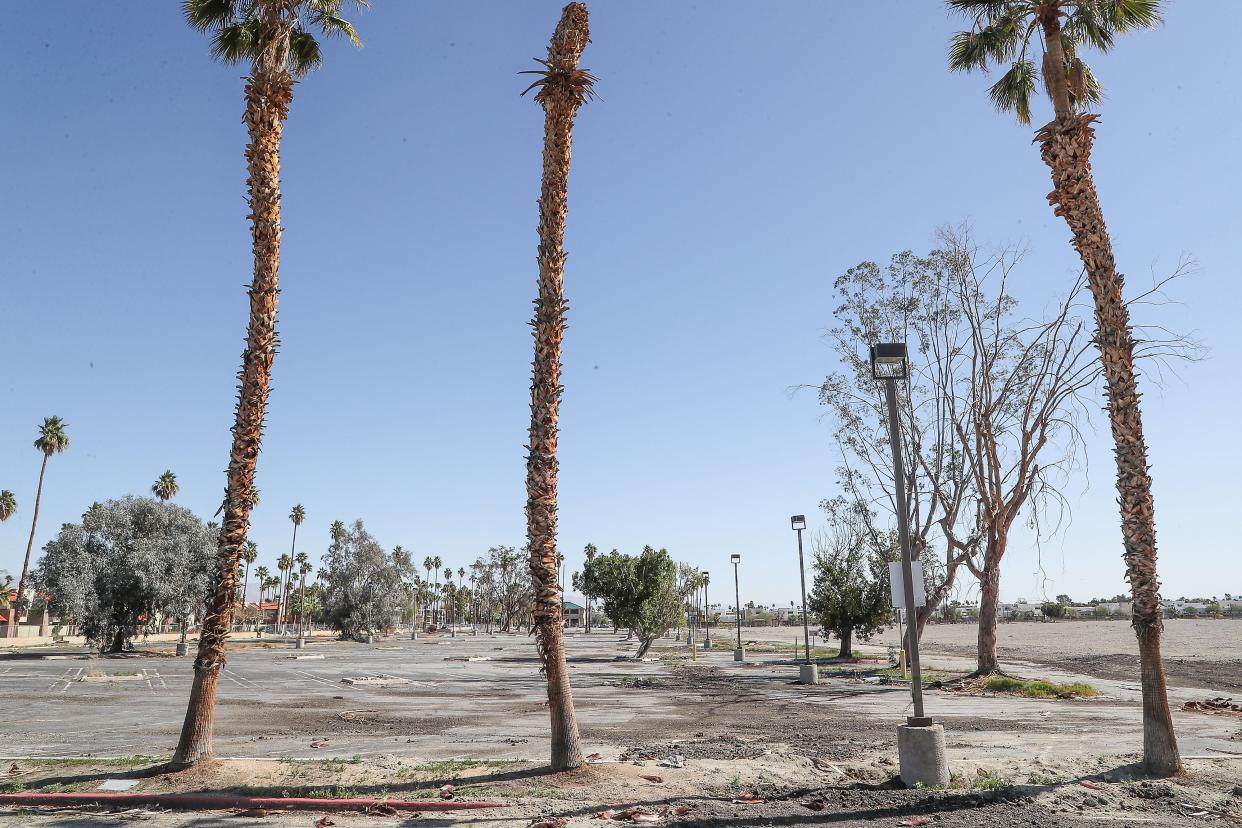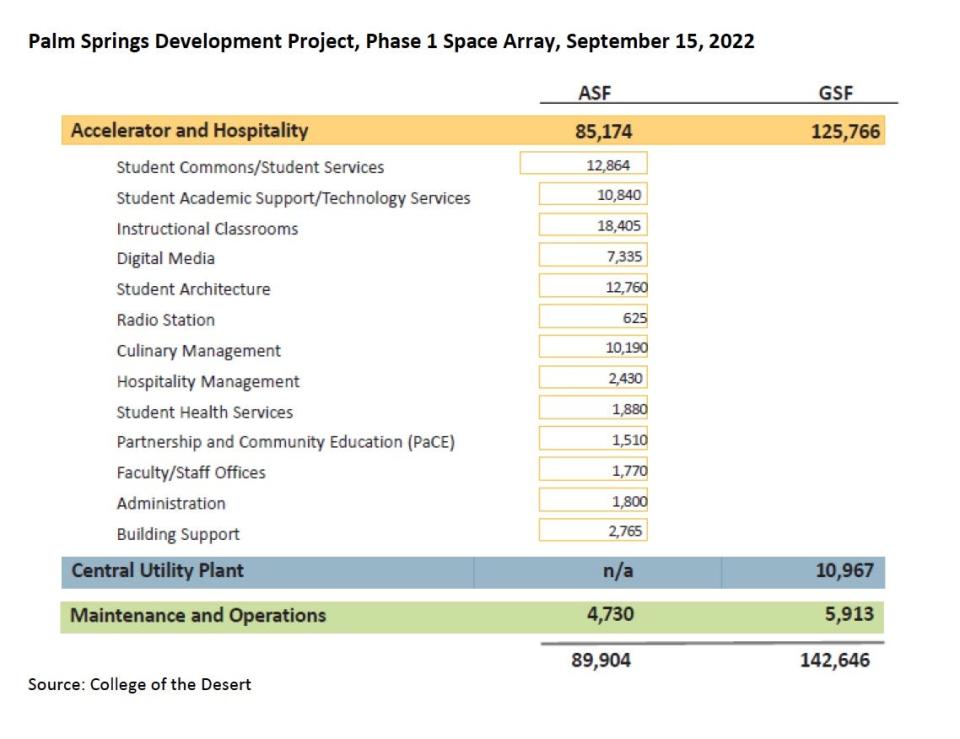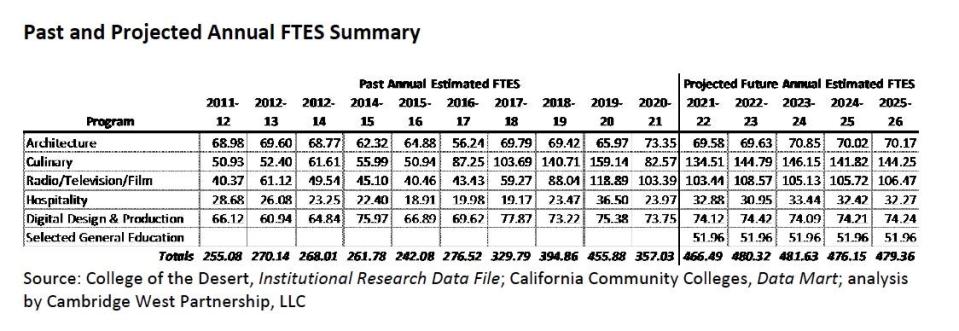Report: COD could struggle to fund $1.5M in annual operating costs for Palm Springs campus

College of the Desert released its Palm Springs campus feasibility study on Monday after months of anticipation.
The board of trustees will review the study and an attached presentation during its meeting at 9:30 a.m. on Thursday. Attendees can observe the meeting in person at the Palm Desert campus or online via Zoom or YouTube. The board agenda can be found here: bit.ly/COD-september. A link to the Zoom room is bit.ly/COD-Zoom.
The report says COD could struggle to fund operating costs for the campus if it is built as planned and enrollment does not substantially increase over the next few years.
It adds COD "has decided to construct 142,646 gross square feet as part of Phase I of the Palm Springs campus," a number never before discussed publicly.
At a forum in August, COD announced plans for 114,000 gross square feet of construction, and said those plans would be subject to change after reviewing community input collected that month. Under former Superintendent/President Joel Kinnamon, COD was considering triple that amount of space.
Plans drawn prior to the pandemic by Kinnamon’s administration called for more than 300,000 gross square feet of buildings, including a 100,000-square-foot learning hotel. Although those plans were developed to 50% schematic design, they never advanced far enough to be reviewed by the board of trustees.
COD has raised nearly $1 billion in bond funds over the past 20 years. That money can be spent solely on land acquisition, construction and equipment.
The report says current construction plans for the Palm Springs campus could support the equivalent of about 3,000 full-time equivalent students, a number based on estimates made in a 2016 environmental impact report for the site produced by the college.
However, the report's authors say the college should expect the equivalent of fewer than 500 full-time students in 2026-27 across five programs slated to be offered in Palm Springs. Many students take classes part-time, and "full-time equivalent students" is a term used across higher education to determine state funding.
The feasibility study, commissioned by the college after Martha Garcia became the school's superintendent/president last summer, was completed by the consulting firm Cambridge West Partnership at a cost of $47,500. It alleges that Kinnamon's administration did not complete a traditional financial feasibility study prior to developing the scope of the Palm Springs campus, and that such a study done earlier would have helped make sure plans were made in accordance with need, it says.
"The information in the study would have been helpful to determine the project scope based on need and affordability," the report reads. "In this case, the feasibility study was conducted concurrent with the capital planning."
Previously, Garcia had said Kinnamon's administration had completed parts but not all of what a traditional feasibility study entails.

The college's most recent plans — unveiled in the report — call for about 142,000 square feet of buildings and no learning hotel in Phase I of the project’s construction. That's slightly larger than plans revealed publicly in August. Phase I will take about five years and cost about $290 million to build, according to the latest cost estimate revealed in this report. That's $10 million more than the cost estimate given in August. The total budget for the campus is $345 million.
The annual $1.5 million operating costs for the campus would cost another approximately $3,000 per full-time equivalent student on an ongoing basis if COD cannot raise its enrollment projections. That does not include instructor salaries.
COD has a plEDGE Program that provides 2022 high school graduates (or equivalent) from the Coachella Valley two full years of free tuition and fees at College of the Desert. Otherwise enrollment fees for students living at home are estimated at $1,288 per nine months. That does not include books, supplies, transportation or other expenses.
COD's tentative 2022-23 budget totals $111 million. About half of that is funded from state revenue and another 40% comes from local property taxes. A small percentage comes from local fees and revenue and federal revenue.
COD expects $106.5 million in expenditures this fiscal year — mostly on salaries and benefits but also including $12 million on services and operating expenses and a couple million each on materials and supplies.
City pushing for larger campus
Meanwhile, Palm Springs city officials are advocating for a larger campus and hospitality school. The city paid for a full-page advertisement in Sunday's Desert Sun to express frustration with COD's recently downsized plans for the campus. At a press conference Monday to announce that Palm Springs is suing COD for what it alleges to be a lack of compliance with the California Public Records Act, Mayor Lisa Middleton also expressed dismay with those plans.
By the time COD plans to open its Palm Springs campus in 2026 or 2027 (college estimates vary in different September board reports), "Nearly 20 years will have passed since COD first voted in 2007 to select Palm Springs for its west valley campus," Middleton said.
"As the years stretch into decades, the size of the campus continues to shrink," she added. "The concepts shared at the recent August presentation are vastly different from what was originally promised to the community."
Middleton told The Desert Sun on Monday she had not yet seen COD's feasibility study and its most recent recommendations and analysis, and added the city would support recommendations for the campus presented last week in a study commissioned by Visit Greater Palm Springs.
"That study has been submitted to the public, and is one that we, as city officials, everyone that I have spoken to, feels very comfortable with the recommendations that were made in that independent study," Middleton said.
That study called for a compromise between COD's August plans and its pre-pandemic plans.
Advisory board members selected
On Thursday, the board will vote to appoint Middleton, Visit Greater Palm Springs President and CEO Scott White and nine other representatives, including several public officials, to a new Palm Springs campus advisory group.
More: College of the Desert makes changes but moves forward with 'Citizens Advisory Group'
The board voted unanimously to create the group last month to inform elements of campus design. The group will meet virtually once or twice per month between now and December to provide feedback on Phase I schematic designs.
College staff originally recommended the body have 7 to 10 members drawn from a specific list of different constituencies, such as students and business leaders. Now, it will have a total of 11 members. Each of the school’s five trustees were able to recommend two members based on any criteria they saw fit, plus one alternate candidate, who could be swapped in as necessary by Garcia or Board Chair Ruben Perez, with the stated goal of creating a diverse mix of participants.
The advisory group also includes:
Scott Matas, Desert Hot Springs mayor
Steven Hernandez, City of Coachella mayor
Dieter Crawford, Palm Springs community activist
Kelly Steward, Ritz Carlton, Rancho Mirage general manager
Patrick Service, Las Casuelas Terraza general partner
Sandy Lyon, former Palm Springs Unified superintendent
Marge Dodge, College of the Desert Foundation board member
Danny Hastings, media producer
Kelly Merchant, student representative
$1.5 million a year to operate
Cambridge West Partnership's estimates that it will cost COD about $1.5 million a year to operate a campus with 142,646 gross square feet of buildings, including costs for utilities, maintenance, grounds and custodial services. It does not include costs for campus security, student services and academic support.
It recommends the college's top priority should be to grow enrollment to cover those operating costs.
“Going forward perhaps the most important administrative goal for the future development of the PSDP Phase I location is to increase the revenue received from attendance and student success outcomes to the point that it at least covers the operating costs for the location,” the report reads.
Between fall 2019 and 2021, COD’s enrollment fell by about 16%, but it appears to have stabilized this semester.
Community college enrollment has declined statewide since the pandemic, and colleges soon may lose state funds unless enrollment rebounds.
"The statewide and regional trend of declining enrollment and the sunsetting of the hold harmless revenue protections in 2024-2025 will make funding the new campus very difficult unless enrollment increases substantially during the next few years," the report says of COD's Palm Springs campus.
The report adds that COD can receive about $2 million per year from the state if the Palm Springs site can attract at least 1,000 annual full-time equivalent students.
On the east side of the valley, COD’s Indio expansion is projected to accommodate about 5,000 additional students, Garcia said this spring. She did not specify how many "full-time equivalent students" that would amount to.
COD's Indio project is projected to cost the college about $73 million, about one-quarter of the cost of the Palm Springs campus, according to a capital projects report to be presented to the citizens bond oversight committee on Tuesday.
Currently, COD’s enrollment across all its campuses for the fall semester is equal to approximately 4,000 full-time equivalent students. Headcount, a measure of unique students taking college classes this fall, is over 11,000. (Many students are enrolled part-time).
About half of current COD students hail from the eastern Coachella Valley and one-third live in the western valley.
What programs will be in Palm Springs?
The report calls for five career technical education programs for Phase I of the Palm Springs campus: architecture, hospitality, culinary arts, film and media arts plus general education.
Collectively, enrollment for these programs is expected to recover from the impact of the COVID-19 pandemic but attract fewer than 500 full-time equivalent students by 2025-26.
The report estimates that the campus will draw:
About 145 full-time equivalent students in culinary arts
About 107 full-time equivalent students in film, TV and radio
About 75 full-time equivalent students in media arts and digital production
About 70 full-time equivalent students in architecture
About 32 full-time equivalent students in hospitality
About 50 full-time equivalent students in general education

The previous COD administration expected hospitality to be the focal point of the campus and hoped to build a state-of-the-art, 100-room training hotel on campus.
The previous administration also hoped to offer a joint architecture program with Cal Poly Pomona that would allow COD students to receive a bachelor’s of architecture degree in five years between the schools. The report says plans for that program will continue.
Cambridge West devised its estimates for programming needs using what it described as a three-year rolling average technique with data provided by the college and the California Community Colleges Chancellor’s Office.
Their estimates also rely on projections from the Southern California Association of Governments’ long-term population forecast for the region. Those forecasts predict the long-term permanent resident population of the Coachella Valley will grow by 32% by 2025 relative to 2020 levels and then continue to grow by about 7% annually out to 2040.
However, the population of people ages 15 to 24 — the population most likely to be contemplating or attending college, according to the report — is expected to decline by 7% between 2022 and 2027 in the cities of Desert Hot Springs, Palm Springs and Cathedral City. In the central Coachella Valley cities, the reduction is anticipated to be a little more severe at 10.1%. Between the two principal cities in the eastern portion of the valley, Indio and Coachella, the decline is expected to be slightly less at 5.9%, according to the report.
Demographics play a role in the report’s projections, too. The median age of Palm Springs households is 56, while it is 33 in Desert Hot Springs and Indio, and 26 in Coachella. The average median age in Riverside County is 35 years old, according to the report.
The report estimates there will be fewer than 7,000 west valley residents ages 18 to 24 by 2027, a decline of 8% relative to that age group’s population currently.
In terms of a labor market analysis, the report says COD will be required to conduct additional research. Garcia has said she needs to see a labor market analysis before proceeding with plans for the Palm Springs campus.
The report includes some labor market estimates from a 2021 study by the Center of Excellence, a research center funded by the chancellor’s office, and it provides estimates for annual regional job openings for occupations traditionally associated with programs available at COD.
Key recommendations in the report
The report recommends COD do the following to boost enrollment to sustain the operating costs of its proposed Palm Springs campus:
Develop a "granular" enrollment management plan with goals for the new site as soon as possible
Improve classroom efficiency to "free up funding for additional ongoing expenses associated with the new site"
Establish "more robust enrollment" at the temporary Palm Springs site as soon as possible
"Aggressively seek" one-time apportionment revenue to offset operational costs until enrollment increases sufficiently to cover new expenses
Establish the goal of qualifying the site as a state-supported educational center (at least 1,000 full-time equivalent students) to receive approximately $2 million annually
Jonathan Horwitz covers education for The Desert Sun. Reach him at jonathan.horwitz@desertsun.com or @Writes_Jonathan.
This article originally appeared on Palm Springs Desert Sun: COD feasibility study recommends smaller campus relative to old plans
